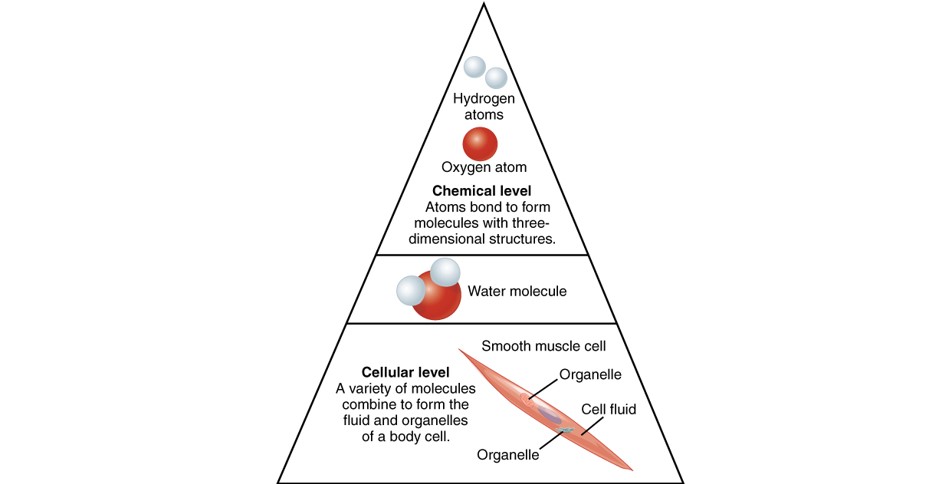Introduction
Levels of Organization
As can be seen, anatomy can be studies in multiple ways, and at various levels. Understanding the hierarchy of these levels, provides context to the complexity of the human organism. The simplest level of organization (although first year chemistry students would disagree) is the chemical level of organization. At this level, simple atoms combine to form relatively simple molecules. For example, carbon dioxide (CO2) is made up of one carbon atom, and two oxygen atoms, and water (H2O) is made up of two hydrogen atoms and one oxygen atom. Macromolecules (macro: big) are larger and more complex, and include four key types in the human body; carbohydrates (sugars), lipids (fats), proteins and nucleic acids (DNA). These four macromolecules form the building blocks of the next level of organization: the cellular level. Cells are the smallest units of life and are responsible for regulating their own environment. The four macromolecules, interact to complete complex tasks for the cell, like generating energy (ATP) or producing muscle contractions (through the interactions of two protein complexes: actin and myosin).

The tissue level of organization consists of a group of cells that work together to accomplish one or more specific functions. There are only four distinct types of tissue in an adult human. Muscle tissue is specialized for contraction to generate movement; neural tissue is specialized for generating action potentials for rapid communication within the body; epithelial tissue provides a physical barrier for entry into the body and produces specialized secretions via glands; and connective tissue shows the greatest variability of all of the tissues, and forms much of the structure of the body (among many other things).

The organ level of organization is when two or more tissues work together for a specific function. For example, the bladder consists of an inner lining of epithelial tissue, bound by various connective tissues to (smooth) muscle. Throughout the bladder, there are also neurons that control the muscle tissue directing it to contract or relax during the urination reflex.

The organ system level of organization is when two or more organs work together for a specific function. The bladder mentioned, when combined with the kidneys (another organ), and the ureters (“tubes” connecting the kidneys to the bladder, form the urinary system (or urinary tract). The kidneys filter the blood, and the waist products drain through the ureters to be stored in the bladder. The waist is eliminated from the body when we urinate.The urinary system is one of the eleven body systems that can be examined using systemic anatomy.

The most complex level of organization is the organismal level, where all eleven organ systems function in the human organism, the whole living person.


